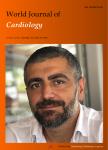Ergonovine stress echocardiography: Recent experience and safety in our centre
Ergonovine stress echocardiography: Recent experience and safety in our centre作者机构:University Clinic San CarlosCardiovascular InstituteProfesor Martín Lagos Street
出 版 物:《World Journal of Cardiology》 (世界心脏病学杂志(英文版)(电子版))
年 卷 期:2010年第2卷第12期
页 面:437-442页
学科分类:0831[工学-生物医学工程(可授工学、理学、医学学位)] 08[工学] 1010[医学-医学技术(可授医学、理学学位)] 10[医学]
主 题:Coronary angiography Ergonovine Myocardial ischaemia Stress echocardiography Vasospasm
摘 要:AIM:To study recent experience and safety of ergonovine stress echocardiography in our ***:In this study we collected the clinical variables of patients referred since 2002 for ergonovine stress echocardiography,in addition to indications,the results of this test,complications,blood pressure and heart rate values during the test and the number and results of tests requested before this ***:We performed 40 tests in 38 patients,2 tests were carried out to verify therapy *** prevalence of classic cardiovascular risk factors was low and the most frequent indication was chest pain (57.5%).Coronary angiography was performed in 32 patients,and showed normal coronary arteries in 27 patients and non-significant stenosis in 5 *** 16 patients,coronary angiography was carried out after a positive or inconclusive ischemia *** 6 patients had a normal stress test(5 exercise electrocardiography tests and 1 nuclear imaging test).Of the 40 ergonovine stress echocardiography tests,6 were positive(4 in the right coronary artery territory and 2 in the circumflex coronary artery territory),all of them by echocardiographic criteria,and by electrocardiographic criteria in only 3(50%).The presence of non-significant coronary artery stenosis was more frequent in patients with positive ergonovine stress echocardiography(50%vs 6%,P =0.038),and were related to ischemic *** the maximum stress stage,there was a higher systolic(130.26±19.17 mmHg vs 136.58±27.27 mmHg,95%CI:-12.77 to 0.14 mmHg,P=0.055)and diastolic blood pressure(77.89±13.49 mmHg vs 83.95± 15.73 mmHg,95%CI:-10.41 to-1.69 mmHg,P=0.008) than at the baseline stage,and the same was registered with heart rate(73±10.96 beats/minvs 79.79± 11.72 beats/min,95%CI:-9.46 to-4.11 beats/min,P 0.01).Nevertheless,there were only 2 hypertensive reactions during the last stage,which did not force a premature end to the test,without sustained tachy or bradyarrhythmias,and the technique was



